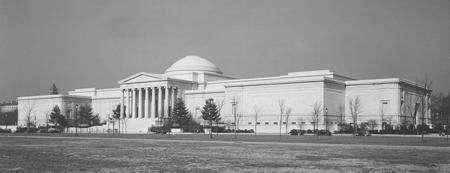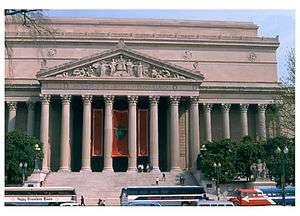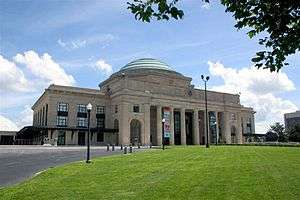John Russell Pope

| Medal record | ||
|---|---|---|
| Art competitions | ||
| Representing the | ||
| Olympic Games | ||
| | 1932 Los Angeles | Architectural design |

John Russell Pope (April 24, 1874 – August 27, 1937) was an American architect whose firm is widely known for designing of the National Archives and Records Administration building (completed in 1935), the Jefferson Memorial (completed in 1943) and the West Building of the National Gallery of Art (completed in 1941), all in Washington, DC.
Biography
Early life
Pope was born in New York in 1874, the son of a successful portrait painter. He studied architecture at Columbia University and graduated in 1894. He was the first recipient of the Rome Prize to attend the newly founded American Academy in Rome,[1] a training ground for the designers of the "American Renaissance." He would remain involved with the Academy until his death.[1]
Pope traveled for two years through Italy and Greece, where he studied, sketched and made measured drawings of more Romanesque, Gothic, and Renaissance structures than he did of the remains of ancient buildings. Pope was one of the first architectural students to master the use of the large-format camera, with glass negatives. Pope attended the École des Beaux-Arts in Paris in 1896,[2] honing his Beaux-Arts style. After returning to New York in 1900, he worked for a few years in the office of Bruce Price before opening his own practice.
American architect

Throughout his career, Pope designed private houses such as Vanderbilt houses, his personal residence at Newport, Rhode Island,[3] and other public buildings besides the Jefferson Memorial and the National Gallery, such as the massive Masonic House of the Temple (1911–15), also in Washington, and the triumphal-arch Theodore Roosevelt Memorial (1936) at the American Museum of Natural History in New York City. He also designed the extension of the Henry Clay Frick mansion in New York City that created the Garden Court and music room among other features as it was expanded to become a museum.
In 1919, he developed a master plan for the future growth of Yale University. Pope's plan for Yale was significantly revised by James Gamble Rogers in 1921 with more sympathy for the requirements of the city of New Haven, Connecticut, but Rogers kept the Collegiate Gothic unifying theme offered by Pope. Pope's original plan is a prime document in the City Beautiful movement in city planning. Pope won a Silver Medal in the 1932 Summer Olympics for his design of the Payne Whitney Gymnasium.[4]

His firm's designs alternated between revivals of Gothic, Georgian, eighteenth-century French, and classical styles. Pope designed the Henry E. Huntington mausoleum on the grounds of The Huntington Library and later used the design as a prototype for the Jefferson Memorial in Washington, D.C. The Jefferson Memorial and the National Gallery of Art were both neoclassical, modeled by Pope on the Roman Pantheon.
Lesser known projects by Pope's firm include Union Station, Richmond, Virginia (1917), with a central rotunda capped with a low saucer dome, now housing the Science Museum of Virginia; Branch House (1917–19), a Tudor-style mansion in Richmond, now housing the Virginia Center for Architecture; the Baltimore Museum of Art; and in Washington, D.C., the National City Christian Church, Constitution Hall, American Pharmacists Association Building, Ward Homestead, and the National Archives Building (illustration, left). In Milwaukee, Wisconsin, he designed a severe neo-Georgian clubhouse for the University Club (1926) and in Oneonta, New York, he designed the first building for Hartwick College: Bresee Hall was constructed in 1928. In 1932, he constructed the chapter house for Alpha Delta Phi at Cornell University in Ithaca, New York. Earlier, he designed the City Hall in Plattsburgh, New York, which was completed in 1917, and the Plattsburgh's Macdonough Monument, erected in 1926 to commemorate the naval victory of Commodore Macdonough in the Battle of Plattsburgh on September 11, 1814.
He designed additions to the Tate Gallery and British Museum in London, an unusual honor for an American architect, and the War Memorial at Montfaucon-d'Argonne, France. Pope was also responsible for extensive alterations to Belcourt, the Newport residence of Oliver and Alva Belmont. The Georgian Revival residence he built in 1919 for Thomas H. Frothingham in Far Hills, New Jersey has been adapted as the United States Golf Association Museum.[5]


Pope was a member of the U.S. Commission of Fine Arts from 1912 to 1922, serving as vice chairman from 1921 to 1922. He also served on the Board of Architectural Consultants for the Federal Triangle complex in Washington, D.C.[6]
Legacy
A 1991 exhibition at the National Gallery of Art, John Russell Pope and the Building of the National Gallery of Art, spurred the reappraisal of his work. For some time, it had been scorned and derided by many critics influenced by International Modernism.
Selected works
- 1911–15: House of the Temple, Washington, D.C.
- 1914–16: Charlcote House, Baltimore, Maryland
- 1916–19: Branch House, Richmond, Virginia
- 1919: Union Station(now the Virginia Science Museum), Richmond, Virginia
- 1926: University Club, Milwaukee, Wisconsin
- 1927: Huntington Mausoleum, San Marino, California
- 1927–28: Woodend, Chevy Chase, Maryland
- 1927–29: Baltimore Museum of Art, Baltimore, Maryland
- 1927±: Skylands Manor, Ringwood, New Jersey (currently the NJ Botanical Garden)
- 1928: Hartwick College (Bresee Hall), Oneonta, New York
- 1929: Constitution Hall, Washington, D.C.
- 1930: National City Christian Church, Washington, D.C.
- 1931: First Congregational Church, Columbus, Ohio
- 1931: Chapter House, Alpha Delta Phi, Cornell University
- 1931–38 The Elgin Gallery, British Museum, London
- 1933–35: National Archives Building, Washington, D.C.
- 1938–41: National Gallery of Art, Washington, D.C.
- 1939–42: Jefferson Memorial, Washington, D.C.
See also
References
- 1 2 "Finding Aid". American Academy in Rome records, 1855–[ca.1981], (bulk dates 1894–1946). Archives of American Art. 2011. Retrieved 17 Jun 2011.
- ↑ Adolf K. Placzek. Macmillan Encyclopedia of Architects. Vol. 3. London: The Free Press, 1982. ISBN 0-02-925000-5. NA40.M25. p450-451.
- ↑ http://sah-archipedia.org/buildings/RI-01-NE168
- ↑ ArchitecturalDigest.com
- ↑ "USGA Golf House & Museum", Historical Society of the Somerset Hills
- ↑ Thomas E. Luebke, ed., Civic Art: A Centennial History of the U.S. Commission of Fine Arts (Washington, D.C.: U.S. Commission of Fine Arts, 2013): Appendix B, p. 552.
- The Games of the Xth Olympiad Los Angeles 1932 (PDF). Xth Olympiade Committee of the Games of Los Angeles, U.S.A. 1932. 1933. pp. 748–765. Archived (PDF) from the original on 2008-04-10.
- Wagner, Juergen. "Olympic Art Competition 1932". Olympic Games Museum. Archived from the original on 2008-05-01.
- Kramer, Bernhard (May 2004). "In Search of the Lost Champions of the Olympic Art Contests" (PDF). Journal of Olympic History. 12 (2): 29–34. Archived (PDF) from the original on 2008-04-10.
- "John Russell Pope". Olympics at Sports-Reference.com. Sports Reference LLC. Retrieved 2016-05-29.
Bibliography
- Bedford, Steven McLeod. John Russell Pope: Architect of Empire, New York: 1998.
- Garrison, James B. Mastering Tradition: The Residential Architecture of John Russell Pope. New York: Acanthus Press, 2004. ISBN 978-0-926494-24-4
External links
| Wikimedia Commons has media related to John Russell Pope. |
- University Club, Milwaukee
- Yale University plan, 1919
- Alpha Delta Phi at Cornell, 1931, John Russell Pope, architect
- John Russell Pope's Master Plan for Dartmouth, 1919
- Pictures and Info on John Russell Pope's Historic Long Island Commissions
- "Blanchard Randall Papers,1914–1969" Baltimore Museum Of Art <https://artbma.org/documents/findingAids/BMA_Board-of-Trustees-Records.pdf>
- "Architect John Russell Pope's Baltimore" March 31 – August 1, 2004. The Baltimore Museum of Art.